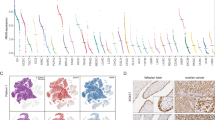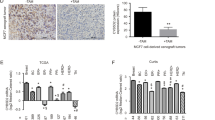Abstract
Although progesterone (P4) has been implicated to offer protection against ovarian cancer (OCa), little is known of its mechanism of action. The goal of this study was to identify P4-regulated genes that have anti-OCa action. Three immortalized nontumorigenic human ovarian surface epithelial (HOSE) cell lines and three OCa (OVCA) cell lines were subjected to 5 days of P4 treatment. Transcriptional profiling with a cDNA microarray containing ≈2400 known genes was used to identify genes (1) whose expression was consistently downregulated in OVCA cell lines compared to HOSE cell lines, and (2) whose expression was restored in OCa cell lines by P4 treatment. From the candidates selected, activating transcription factor-3 (ATF-3), caveolin-1, deleted in liver cancer-1 (DLC-1), and nonmetastatic clone 23 (NM23-H2) were chosen for post hoc functional studies based on their previously reported action as tumor suppressors or apoptosis inducers. Semiquantitative RT–PCR analyses confirmed loss of or reduced transcription of these genes in OVCA cells when compared to HOSE cells and their upregulation following P4 treatment. Hormonal specificity was demonstrated by blockade experiments with a progestin antagonist RU 38486. Ectopic expression of caveolin-1, DLC-1, and NM23-H2 caused growth inhibition in OVCA cell cultures, but not in HOSE cell cultures, while forced expression of ATF-3 suppressed growth in both. Overexpression of AFT-3 also enhanced caspase-3 activity in both HOSE and OVCA cells, whereas ectopic expression of caveolin-1 and DLC-1 only activated this enzyme in OCa cells. In contrast, NM23-H2 overexpression was ineffective in activating caspase-3. Overexpression of any of the four genes in OCa cells reduced soft-agar colony formation and cell invasiveness. Taken together, we have identified four new P4-regulated, antitumor genes for OCa. However, their modes of action differ significantly; ATF-3 primarily functions as an apoptosis inducer, NM23-H2 as a suppressor of cell motility, and caveolin-1 and DLC-1 exhibiting features of classical tumor suppressors. To the best of our knowledge, except for NM23-H2, this is the first report linking P4 to the regulation of these tumor suppressor/proapoptotic genes, which could serve as future therapeutic targets.
This is a preview of subscription content, access via your institution
Access options
Subscribe to this journal
Receive 50 print issues and online access
$259.00 per year
only $5.18 per issue
Buy this article
- Purchase on Springer Link
- Instant access to full article PDF
Prices may be subject to local taxes which are calculated during checkout








Similar content being viewed by others
References
Adami HO, Hsieh CC, Lambe M, Trichopoulos D, Leon D, Persson I, Ekbom A and Janson PO . (1994). Lancet, 344, 1250–1254.
Athanassiadou P, Petrakakou E, Sakelariou V, Zerva C, Liossi A, Michalas S and Athanassiades P . (1998). Eur. J. Cancer Prev., 7, 225–231.
Bast Jr RC, Feeney M, Lazarus H, Nadler LM, Colvin RB and Knapp RC . (1981). J. Clin. Invest., 68, 1331–1337.
Bender FC, Reymond MA, Bron C and Quest AF . (2000). Cancer Res., 60, 5870–5878.
Bu SZ, Yin DL, Ren XH, Jiang LZ, Wu ZJ, Gao QR and Pei G . (1997). Cancer, 79, 1944–1950.
Callow ME, Callow JA, Ista LK, Coleman SE, Nolasco AC and Lopez GP . (2000). Appl. Environ. Microbiol., 66, 3249–3254.
Cramer DW, Hutchinson GB, Welch WR, Scully RF and Knapp RC . (1982). N. Engl. J. Med., 307, 1047–1051.
Cheng KW, Cheng CK and Leung PC . (2001). Mol. Endocrinol., 15, 2078–2092.
Das H, Koizumi T, Sugimoto T, Chakraborty S, Ichimura T, Hasegawa K and Nishimura R . (2000). Br. J. Cancer, 82, 1682–1688.
Davis M, Hitchcock A, Foulkes WD and Campbell IG . (1996). Cancer Res., 56, 741–744.
Engelman JA, Zhang XL and Lisanti MP . (1998). FEBS Lett., 436, 403–410.
Evans RM . (1988). Science, 240, 889–895.
Freshney RI . (1994). A Manual of Basic Techniques 3rd edn. Wiley-Liss A: John Wiley and Sons inc.
Fournier HN, Albiges-Rizo C and Block MR . (2003). J. Bioenerg. Biomembr., 35, 81–87.
Gabra H, Taylor L, Cohen BB, Lessels A, Eccles DM, Leonard RC, Smyth JF and Steel CM . (1995). Br. J. Cancer, 72, 367–375.
Gabra H, Watson JE, Taylor KJ, Mackay J, Leonard RC, Steel CM, Porteous DJ and Smyth JF . (1996). Cancer Res., 56, 950–954.
Giangrande PH, Kimbrel EA, Edwards DP and McDonnell DP . (2000). Mol. Cell. Biol., 20, 3102–3115.
Giangrande PH, Pollio G and McDonnell DP . (1997). J. Biol. Chem., 272, 32889–32900.
Hai T and Hartman . (2001). Gene, 273, 1–11.
Hai T, Wolfgang CD, Marsee DK, Allen AE and Sivaprasad U . (1999). Gene Expr., 7, 321–335.
Ho SM . (2003). Reprod. Biol. Endocrinol., 1, 73–80.
Ho SM, Lau KM, Mok SC and Syed V . (2003). Oncogene, 22, 4243–4256.
Holschneider CH and Berek JS . (2000). Semin. Surg. Oncol., 19, 3–10.
Hu Z and Deng X . (2000). Zhonghua Fu Chan Ke Za Zhi, 35, 423–426.
Keith BM and Bonavida B . (2001). Gynecol. Oncol., 82, 127–138.
Kim TY, Jong HS, Song SH, Dimtchev A, Jeong SJ, Lee JW, Kim TY, Kim NK, Jung M and Bang YJ . (2003). Oncogene, 22, 3943–39451.
Koike M, Takeuchi S, Park S, Hatta Y, Yokota J, Tsuruoka N and Koeffler HP . (1999). Oncology, 56, 160–163.
La Vecchia C . (2001). Eur. J. Cancer Prev., 10, 125–129.
Lau KM, Mok SC and Ho SM . (1999). Proc. Natl. Acad. Sci. USA, 96, 5722–5727.
Lau KM, Tam NN, Thompson C, Cheng RY, Leung YK and Ho SM . (2003). Lab. Invest., 83, 743–757.
Liang G, Wolfgang C, Chen B, Chen T and Hai T . (1996). J. Biol. Chem., 271, 1695–1701.
Lyons-Weiler J, Patel S and Bhattacharya S . (2003). Genome Res., 13, 503–512.
Makrigiannakis A, Coukos G, Christofidou-Solomidou M, Montas S and Coutifaris C . (2000). Acad. Sci., 900, 16–25.
Mandai M, Konishi I, Komatsu T, Mori T, Arao S, Nomura H, Kanda Y, Hiai H and Fukumoto M . (1995). Br. J. Cancer., 72, 691–695.
Mashima T, Udagawa S and Tsuruo T . (2001). J. Cell. Physiol., 188, 352–358.
Modan B, Ron E, Lerner-Geva L, Blumstein T, Menczer J, Rabinovici J, Oelsner G, Freedman L, Mashiach S and Lunenfeld B . (1998). Am. J. Epidemiol., 147, 1038–1042.
Murdoch WJ and McDonnel AC . (2002). Reproduction, 123, 743–750.
Ng IO, Liang ZD, Cao L and Lee TK . (2000). Cancer Res., 60, 6581–6584.
Nishizuka S, Tamura G, Terashima M and Satodate R . (1997). Br. J. Cancer, 76, 1567–1571.
Ouatas T, Halverson D and Steeg PS . (2003). Clin. Cancer Res., 9, 3763–3772.
Patel S and Lyons-Weiler J . (2004). Appl. Bioinform., 3, 49–62.
Plaumann M, Seitz S, Frege R, Estevez-Schwarz L and Scherneck S . (2003). J. Cancer Res. Clin. Oncol., 129, 349–354.
Racine C, Belanger M, Hirabayashi H, Boucher M, Chakir J and Couet J . (1999). Biochem. Biophys. Res. Commun., 255, 580–586.
Risch HA . (1998). J. Natl. Cancer Inst., 90, 1774–1786.
Salazar-Martinez E, Lazcano-Ponce EC, Gonzalez Lira-Lira G, Escudero-De los RP, Salmeron-Castro J and Hernandez-Avila M . (1999). Cancer Res., 59, 3658–3662.
Sartorius CA, Shen T and Horwitz KB . (2003). Breast Cancer Res. Treat., 79, 287–299.
Schildkraut JM, Calingaert B, Marchbanks PA, Moorman PG and Rodriguez GC . (2002). J. Natl. Cancer Inst., 94, 32–38.
Schneider HP and Birkhauser M . (1995). Int. J. Fertil. Menopausal Stud. Suppl., 1, 40–53.
Shao R, Markstrom E, Friberg PA, Johansson M and Billig H . (2003). Biol. Reprod., 68, 914–921.
Shridhar V, Sun QC, Miller OJ, Kalemkerian GP, Petros J and Smith DI . (1997). Oncogene, 15, 2727–2733.
Syed V and Ho SM . (2003). Oncogene, 22, 6883–6890.
Syed V, Ulinski G, Mok SC and Ho SM . (2002). J. Natl. Cancer Inst., 94, 617–629.
Syed V, Ulinski G, Mok SC, Yiu GK and Ho SM . (2001). Cancer Res., 61, 6768–6776.
TambyRaja RL and Ratnam SS . (1981). Progress in Clinical and Biological Research Gedda I, Parisi P, Nance W (eds) Alan R Liss: New York, P. 149.
Tas F, Tuzlali S, Aydiner A, Saip P, Salihoglu Y, Iplikci A and Topuz E . (2002). Am. J. Clin. Oncol., 25, 164–167.
Thomas HV, Murphy MF, Key TJ, Fentiman IS, Allen DS and Kinlen LJ . (1998). Ann. Hum. Biol., 25, 69–75.
Tsao SW, Mok SC, Fey EG, Fletcher JA, Wan TS, Chew EC, Muto MG, Knapp RC and Berkowitz RS . (1995). Exp. Cell. Res., 218, 499–507.
Wiechen K, Diatchenko L, Agoulnik A, Scharff KM, Schober H, Arlt K, Zhumabayeva B, Siebert PD, Dietel M, Schafer R and Sers C . (2001). Am. J. Pathol., 159, 1635–1643.
Wolfgang CD, Liang G, Okamoto Y, Allen AE and Hai T . (2000). J. Biol. Chem., 275, 16865–16870.
Xu X, Murdoch FE, Curran EM, Welshons WV and Fritsch MK . (2004). Gene, 328, 143–151.
Yang YH, Dudoit S, Luu P, Lin DM, Peng V, Ngai J and Speed TP . (2002). Nucleic Acids Res., 30, e15.
Yen SS . (1994). Maternal-Fetal Medicine: Principles and Practice. Creasy, RK, Rensik R (eds) Saunders: Philadelphia, pp. 382–412.
Yu S, Lee M, Shin S and Park J . (2001). J. Cell. Biochem., 82, 445–451.
Yuan BZ, Miller MJ, Keck CL, Zimonjic DB, Thorgeirsson SS and Popescu NC . (1998). Cancer Res., 58, 2196–2199.
Yuan BZ, Zhou X, Durkin ME, Zimonjic DB, Gumundsdottir K, Eyfjord JE, Thorgeirsson SS and Popescu NC . (2003). Oncogene, 22, 445–450.
Zenklusen JC, Thompson JC, Troncoso P, Kagan J and Conti CJ . (1994). Cancer Res., 54, 6370–6373.
Zhu Y, Bond J and Thomas P . (2003). Proc. Natl. Acad. Sci. USA, 100, 2237–2242.
Acknowledgements
We thank Dr Irene Ng, University of Hong Kong, China for providing DLC-1 expression vector, Dr Christine Sers, Charite, Humboldt University, Berlin, Germany for kindly providing caveolin-1 expression vector, Dr Carl V Hamby, New York Medical College Valhalla, New York, USA for providing NM23-H2 expression vector, and Dr Samuel C Mok, Laboratory of Gynecologic Oncology, Department of Obstetrics, Gynecology, and Reproductive Biology, Brigham and Women's Hospital, Harvard Medical School, Boston for providing HOSE and OVCA cell lines. We thank Mr Bhavesh Patel for technical assistance and the editorial staff of Brigham and Women's Hospital, Harvard Medical School, Boston, for editorial help. This study was supported in part by NIH Grants CA091250 (to V Syed) and CA94221 (to S-M Ho).
Author information
Authors and Affiliations
Corresponding author
Rights and permissions
About this article
Cite this article
Syed, V., Mukherjee, K., Lyons-Weiler, J. et al. Identification of ATF-3, caveolin-1, DLC-1, and NM23-H2 as putative antitumorigenic, progesterone-regulated genes for ovarian cancer cells by gene profiling. Oncogene 24, 1774–1787 (2005). https://doi.org/10.1038/sj.onc.1207991
Received:
Revised:
Accepted:
Published:
Issue Date:
DOI: https://doi.org/10.1038/sj.onc.1207991
Keywords
This article is cited by
-
Targeting purine metabolism in ovarian cancer
Journal of Ovarian Research (2022)
-
ATF3 deficiency impairs the proliferative–secretory phase transition and decidualization in RIF patients
Cell Death & Disease (2021)
-
Progesterone reduces cell survival in primary cultures of endometrioid ovarian cancer
Journal of Ovarian Research (2019)
-
Activating transcription factor 3 promotes embryo attachment via up-regulation of leukemia inhibitory factor in vitro
Reproductive Biology and Endocrinology (2017)
-
ARHGAP10, downregulated in ovarian cancer, suppresses tumorigenicity of ovarian cancer cells
Cell Death & Disease (2016)



